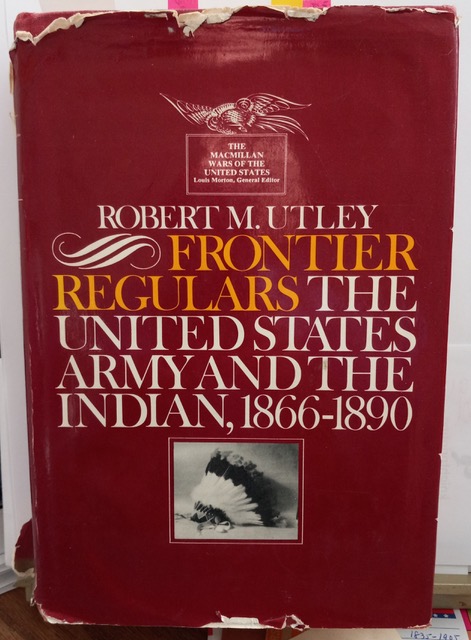A lot of us knew Bob Utley as the Old Bison, probably because of his years poking around the West. Without question, he was the dean of Indian Wars history, trading not in myths and legends, but the facts of American history that pitted the U.S. Army, serving as arm of the federal government, against the indigenous peoples on what was the western frontier.
I suppose a lot of us Indian Wars historians figured Bob would be around forever. It seems that a lot of historians seem to live to a great good age, maybe so they can become history, itself. Bob died June 7, 2022, in Scottsdale, Arizona, where he and his wife Melody Webb, also a historian and former National Park Service ranger, had retired. He would have been 93 years old, had he made it to Halloween this year.
I met Bob in 1980 when he spoke at Golden Spike National Monument, a.k.a. Promontory Summit, where railroads came together in 1869. We stayed in minimal touch. Years later, he consented to becoming the subject of my master’s thesis. I still smile about that. “Can’t you find a better subject, Carla?” he asked me. Well, no, I couldn’t. What followed were personal interviews, and phone work, and interviewing other historians about him. The result was my thesis, Robert Utley: Carrying History to the People.
Bob was born Oct. 31, 1929, in Bauxite, Arkansas, where his father was a chemist for Alcoa, the Aluminum Company of America. Bob was always close to his grandfather Joseph Utley, who served as attorney general of Arkansas, and later a district judge. He wanted to be a lawyer like his grandfather.
Everyone has a story about how they got into history. (Mine was reading Francis Parkman’s The Oregon Trail.) When he was 12, Bob went to a Saturday afternoon matinee of They Died with Their Boots On, a swashbuckling Errol Flynn epic about George Armstrong Custer and the Little Big Horn. “That was my introduction to Custer,” Bob told me. “It was hero worship.”
Before he graduated from high school, he saved up for a bus ticket to Custer Battlefield National Monument, now called Little Bighorn National Monument. The superintendent turned him loose, and Bob was hooked. Through a real bit of earnest endeavor and sheer luck, Bob started working there during the summers as a seasonal ranger before he graduated from high school. Unheard of, but Bob managed it for six years.
He attended Purdue University and graduated in 1951 with a degree in history. Still intent on the study of law, he ended up in the U.S. Army for the duration of the Korean War. Many details follow, but through that love of history, and some well-placed help from historians who saw his great promise, Bob ended up working full time in the National Park Service, eventually becoming Chief Historian.
Bob was a public historian, as are all those ranger/historians at NPS history sites. I was one for some wonderful seasons at Fort Laramie NHS and Fort Union Trading Post NHS. A public historian tells America’s story to visitors at historic sites and national monuments. What great work. I miss it to this day. In Bob’s case, he also made that history accessible to all, not just professors. He told and wrote America’s story.
Bib was responsible for bringing many Indian Wars garrisons into the NPS system, and other landmarks of Western history. My personal favorite is Fort Davis National Historic Site, located near Alpine, Texas, in the Davis Mountains. Many of the remaining buildings have been restored to tell that Indian Wars story. I’m also fond of Bent’s Old Fort National Historic Site, near La Junta, Colorado, on the Santa Fe Trail.
Time and tide change things. In those earlier days, the emphasis was nearly exclusively on the army side of the wars. Now the focus is on the Indian side of the story. I hope to ultimately see a better balance between both. It’ll come.
Through all these years, Bob was busy writing that history, as well as ushering it into the NPS. Probably the Bible of Indian Wars history is Bob’s Frontier Regulars: The United States Army and the American Indian, 1866-1890. It was published in 1973, and followed a few years later by Frontiersmen in Blue, covering 1848-1865. Many other books followed, several focusing on his earlier interest in Custer. I never shared his deep interest in Custer, but I read those books anyway because above and beyond anything, Bob could write well.
Jerry Greene, a retired NPS historian, told me this as I was interviewing him over the phone for my thesis in 1992. Jerry attended a talk Bob gave to the Colorado Historical Society. “At the end of the talk,” Jerry said, “someone asked Bob, ‘How do you write so beautifully?’ Bob replied, ‘I just see it in my mind and I write what I see.’” See? It’s simple.
Bob taught me a lot. He was known for careful, meticulous research, and well-reasoned. “This is the essence of being a historian,” he told me. “You’re not contributing unless you take a fresh look.”
My personal favorite advice? It was also vintage Bob Utley. Part of my thesis was divining just how he wrote history. He outlined each chapter heavily and wrote from that. I tend to do that in my historical fiction. It’s a great tool.
Then, as a bit of a joke – I knew him well enough by then – I asked Bob what was his secret weapon for writing history. I love his reply: “Carla, you put your ass in the chair and leave it there until you’re done.”
Perfect.
CK

